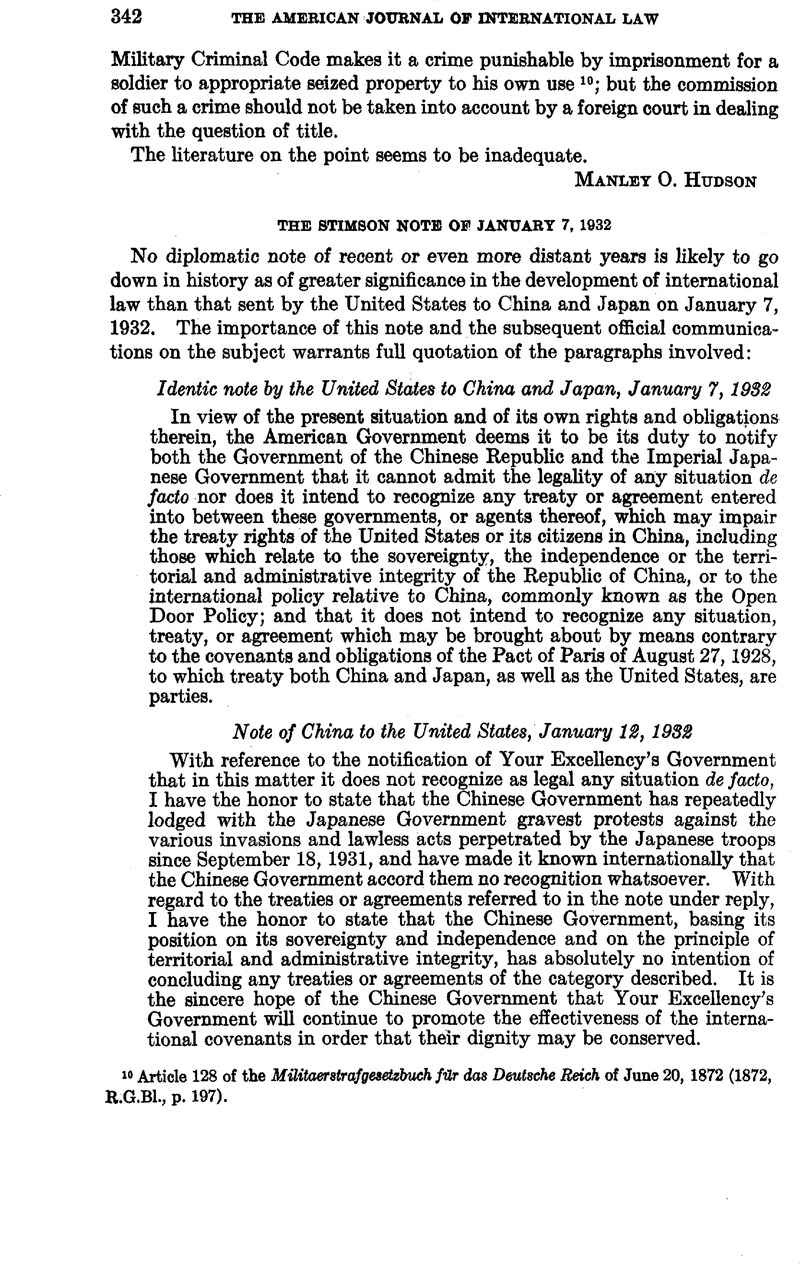Published online by Cambridge University Press: 12 April 2017

1 “To say that force cannot give a good legal title is to divorce international law from the actual practice of nations in all known periods of history … The civil society of medieval England and the international relations (society) on this planet in the 20th century… possessed few and imperfect general conceptions of law…. Recognition by other powers of a new seisin has in the past been good evidence that there has been a definitive change, but such recognition has often been delayed until long after the change has been definitive…. We shall do nothing—except administer a little opium to our mental and moral vigor—by saying that war and conquest while we allow them to take place, produce results which are invalid in law.” Sir John Fischer Williams, “Sovereignty, Seisin and the League,” British Year Book of International Law, 1926, pp. 35,37, 40, 42. A similar view is expressed by A. Lawrence Lowell, “Manchuria, the League and the United States,” Foreign Affairs, April, 1932, Vol. 10, p. 368. See also Wright, Mandates under the League of Nations, 1930, pp. 370-372.
2 Williams, loc. cit.; Cobbett, Leading Cases in International Law, 1913, Vol. 2, p. 245; Fauchille, Traité de droit int. pub., Vol. 1, Pt. 2, sec. 557; Hyde, International Law, Vol. 1, pp. 175-177; Phillipson, Termination of War and Treaties of Peace, 1916, p. 19.
3 Rdectiones Theologicae, 1557, ed. 1696, p. 428, Classics of International Law edition, pp. 170, 278, 428.
4 Fleming v. Page, 1850, 9 How. 603.
5 Moore's Int. Law Dig., Vol. 6, p. 402.
6 League of Nations, Doc. A, 17 (1923) v; Wright, Am. Pol. Sci. Rev., Nov. 1919, Vol. 13, p. 559; Mandates under the League of Nations, p. 371. Sir John Fischer Williams (he. cit.) appears to hold that Art. 10 is designed not to protect legal title to territory but, like Henry II's Assize Novel Disseisin, to protect existing seisin even though such seisin was recently established by force.
7 Oppenheim, International Law, 3rd ed., Vol. 1, p. 662; Wilson, International Law, 2nd ed., p. 203; Roxburgh, International Conventions and Third States, 1917, p. 32 jf.; Wright, "Conflicts between International Law and Treaties," this JOURNAL, Vol. 11 (1917), p. 576 ff.
8 Hyde, International Law, Vol. 2, pp. 5-6. See numerous incidents cited by Myers, "Violation of Treaties," this JOURNAL, Vol. 11 (1917), pp. 797-813.
9 Costa Rica v. Nicaragua, Central American Court of Justice, Sept. 30,1916, this JOURNAL Vol. 11 (1917), p. 181; Supp., Vol. 11, pp. 3-13.
10 League of Nations Covenant, Art. 20.
11 U. S. For. Rel., 1915, p. 146; Willoughby, Foreign Rights and Interests in China, 1927, Vol. 1, p. 237.
12 U. S. For. Rel., 1917, p. 270; Willoughby, op. cit., Vol. 1, p. 363.
13 Wilson, op. cit, p. 189; Oppenheim, op. tit., Vol. 1, p. 660; Hall, International Law, 8th ed., pp. 381-382.
14 Phillipson, op. cit., p. 162.
15 Young, Japan's Jurisdiction and International Legal Position in Manchuria, 1931, Vol. 2, p. 163 ff.
16 Lauterpacht, Private Law Sources and Analogies in International Law, 1927, p. 160 ff.
17 Ibid., pp. 85 ff., 161 ff.